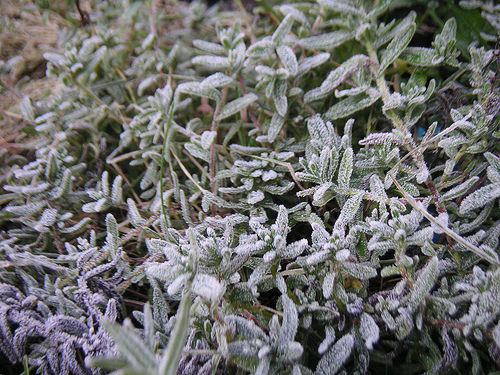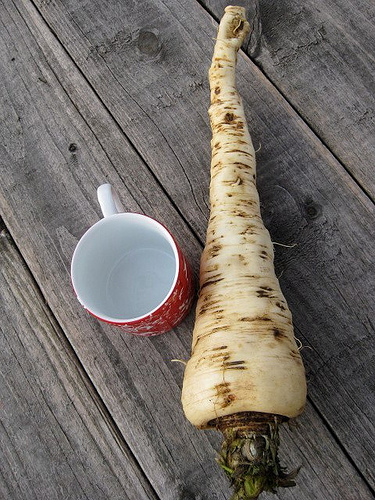Community /
Blogs
The opinions expressed in these blogs are solely those of the people who wrote them, and do not represent the views of WPSU or Penn State University.
Local Food Journey
Frost looms in the garden, but that’s not always a bad thing
Posted by Jamie Oberdick on 09/29 at 07:19 AM

Frosty scenes like this will soon be common Photo courtesy of davosmith via Creative Commons
While the weather in recent days has been more like summer, the changing leaves are a definite sign that it is autumn and gardening season is coming to a close. While much of central Pennsylvania hasn’t seen the first frost as yet, that soon will change. It’s definitely frost season.
As you can see on this State College National Weather Service page, the average date of first freeze is generally Sept. 30 to Oct. 10. There is not a lot you can do as a gardener to protect frost-sensitive plants from a hard freeze, but if you are like me, you want to do your best to try to coax as many growing days out of the year as possible. For example, I have some peppers nearing harvest size that I would like to get, along with some tomatoes, and I don’t want to give up on getting them just yet.
So, if the forecast is for 33-36 and calm/clear conditions, frost can form. You can do a few things to protect your plants, but the easiest is simply to cover them with a tarp, a sheet, anything that will prevent frost formation. Once the temperature gets above 36 in the morning, you can remove the sheet.
Keep in mind that most of the “cool season” crops you are growing in the fall are frost hardy. Do a bit of research to find out what can handle a light frost. Some plants, like broccoli, cabbage, lettuce, peas, etc. can take a light frost and keep on going. There are even plants that can handle freezing temperatures. Tatsoi, a very tasty Chinese mustard green, can handle temperatures as low as 15 degrees! I have also harvested things like green onions, tatsoi, parsley, parsnips, and others while there is snow on the ground.

The parsnip’s sweet, delicious flavor is enhanced by frost, so it pays to wait to harvest until after first frost.
Believe it or not, some plants like Swiss chard, cabbages, parsnips, carrots, and salsify actually taste better after a frost, due to increase in natural sugars making them sweeter. You can even leave parsnips under mulch and harvest them in the winter if the ground isn’t frozen. They taste fantastic.
A final note on frost - pay attention to weather forecasts to help you make determinations if you want to protect your garden. You can go to the National Weather Service State College site and then type in your zip code to get a local forecast, including frost advisories and freeze warnings when they are issued.
However, there are such a thing as microclimates - generally lower areas are more at risk to frost, such as valleys and even lower portions of your property. It really can be that localized. A good idea is to take note on colder mornings where frost is thickest, then plan accordingly. If you see frost in your property and not much elsewhere, you live in a microclimate favorable to frost formation. If you note nearby areas have more frost than you do, then you are not at as much risk. Still, if you really want to save plants, better safe than sorry.
With all this in mind, a quick glance at the weather forecast for this weekend says we may be at risk of frost, so plan accordingly, and stay warm.
![]() Author: Jamie Oberdick
Author: Jamie Oberdick
Bio: Editor, Local Food Journey | Passionate about supporting local food in Central PA
Leave a Comment
Commenting is not available in this section entry. « Album Review: Thrice - Major/Minor Album Review: Saves The Day - Daybreak »Most recent entries
 Our Local Food Journey comes to an end
Our Local Food Journey comes to an end- Wednesday, January 31, 2018
- By Jamie Oberdick in Local Food Journey
 Winter isn’t a quiet time at the farm
Winter isn’t a quiet time at the farm- Wednesday, January 31, 2018
- By James Eisenstein in Local Food Journey
 Get the taste of garden season right now by growing herbs indoors
Get the taste of garden season right now by growing herbs indoors- Friday, January 26, 2018
- By Jamie Oberdick in Local Food Journey
 All you need to know about PASA’s Farming for the Future conference
All you need to know about PASA’s Farming for the Future conference- Friday, January 19, 2018
- By Jamie Oberdick in Local Food Journey
Categories
Archives
- January 2018
- December 2017
- November 2017
- October 2017
- September 2017
- August 2017
- July 2017
- June 2017
- May 2017
- April 2017
- March 2017
- February 2017
- January 2017
- December 2016
- November 2016
- October 2016
- September 2016
- August 2016
- July 2016
- June 2016
- May 2016
- April 2016
- March 2016
- February 2016
- January 2016
- December 2015
- November 2015
- October 2015
- September 2015
- August 2015
- July 2015
- June 2015
- May 2015
- April 2015
- March 2015
- February 2015
- January 2015
- December 2014
- November 2014
- October 2014
- September 2014
- August 2014
- July 2014
- June 2014
- May 2014
- April 2014
- March 2014
- February 2014
- January 2014
- December 2013
- November 2013
- October 2013
- September 2013
- August 2013
- July 2013
- June 2013
- May 2013
- April 2013
- March 2013
- February 2013
- January 2013
- December 2012
- November 2012
- October 2012
- September 2012
- August 2012
- July 2012
- June 2012
- May 2012
- April 2012
- March 2012
- February 2012
- January 2012
- December 2011
- November 2011
- October 2011
- September 2011
- August 2011
- July 2011
- June 2011
- May 2011
- April 2011
- March 2011
- February 2011
- January 2011
- December 2010
- November 2010
- October 2010
- September 2010
- August 2010
- July 2010
- June 2010
- May 2010
- April 2010
- March 2010
- February 2010
- January 2010
- December 2009
- November 2009
- October 2009
- September 2009
- August 2009
- July 2009
- June 2009
- May 2009
- April 2009
- March 2009
- February 2009

NO COMMENTS